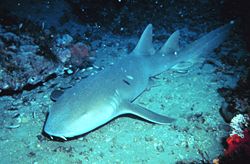Nurse shark: Difference between revisions
No edit summary |
GrahamBould (talk | contribs) m rv |
||
| Line 51: | Line 51: | ||
A character in the cartoon [[Camp Lazlo]] named [[List_of_characters_in_Camp_Lazlo#Nurse_Leslie|Nurse Leslie]] is a nurse shark. |
A character in the cartoon [[Camp Lazlo]] named [[List_of_characters_in_Camp_Lazlo#Nurse_Leslie|Nurse Leslie]] is a nurse shark. |
||
In an episode of The Simpsons, Milhouse claims, "If I were to be any shark, it would probably be a Nurse Shark." He is subsequently beat up |
|||
by Nelson and his gang. |
|||
==Gallery== |
==Gallery== |
||
Revision as of 11:30, 28 March 2007
| Nurse shark | |
|---|---|

| |
| Ginglymostoma cirratum | |
| Scientific classification | |
| Kingdom: | |
| Phylum: | |
| Class: | |
| Subclass: | |
| Order: | |
| Family: | |
| Genus: | Ginglymostoma |
| Binomial name | |
| Ginglymostoma cirratum (Bonnaterre, 1788)
| |
The nurse shark, Ginglymostoma cirratum, is a shark in the nurse sharks family, the only member of its genus Ginglymostoma. It may reach a length of 4.3 m.
Taxonomy
The name nurse shark is thought to be a corruption of nusse, a name which once referred to the catsharks of the family Scyliorhinidae. The nurse shark family name, Ginglymostomatidae, derives from the Greek: from γίγγλυμος meaning hinge and στῶμα meaning mouth.
Distribution and habitat
The nurse shark is a common inshore bottom-dwelling shark, found in tropical and subtropical waters on the continental and insular shelves. It is frequently found at depths of 1 metre or less but may occur down to 12 m. Its common habitats are reefs, channels between mangrove islands and sand flats. It occurs in the Western Atlantic from Rhode Island down to southern Brazil;in the Eastern Atlantic from Cameroon to Gabon (and possibly ranges further north and south); in the Eastern Pacific from the southern Baja California to Peru; and around the islands of the Caribbean.[1]
Behaviour and diet
Nurse sharks are nocturnal animals, spending the day in large inactive groups of up to 40 individuals. Hidden under submerged ledges or in crevices within the reef, the nurse sharks seem to prefer specific resting sites and will return to them each day after the night's hunting. By night, the sharks are largely solitary; they spend most of their time rifling through the bottom sediments in search of food. Their diet consists primarily of crustaceans, molluscs, tunicates, and other fish, particularly stingrays.
Their diet consists of a large number of marine invertebrates - spiny lobsters, crabs, shrimps, sea urchins, octopuses, squid, and marine snails and bivalves.
They are thought to take advantage of dormant fish which would otherwise be too fast for the sharks to catch; although their small mouths limit the size of prey items, the sharks have large throat cavities which are used as a sort of bellows valve. In this way nurse sharks are able to suck in their prey. Nurse sharks are also known to graze algae and coral.
Nurse sharks have been observed resting on the bottom with their bodies supported on their fins, possibly providing a false shelter for crustaceans which they then ambush and eat.[1]
Reproduction
The mating season runs from late June to the end of July. Nurse sharks are ovoviviparous, meaning the eggs develop and hatch within the body of the female where the hatchlings develop further until live birth occurs. The gestation period is six months, with a typical litter of 21 - 28 pups.[1] The mating cycle is biennial, as it takes 18 months for the female's ovaries to produce another batch of eggs. The young nurse sharks are born fully developed at about 30 centimetres long in Ginglymostoma cirratum. They possess a spotted coloration which fades with age.
Interaction with humans
The nurse shark is not widely commercially fished, but because of its sluggish behaviour it is an easy target for local fisheries. Its skin is exceptionally tough and is prized for leather; its flesh consumed fresh and salted and its liver utilised for oil. It is not taken as a game fish. It has been reported in some unprovoked attacks on humans but is not generally perceived as a threat.[1]
Popular Culture
A character in the cartoon Camp Lazlo named Nurse Leslie is a nurse shark.
Gallery
-
Nurse shark with attached remoras
-
Nurse shark in an aquarium
-
Nurse sharks at the bottom of Mayan Temple Water Slides at Atlantis
See also
References
- Template:IUCN2006 Database entry includes justification for why this species is listed as data deficient
- "Ginglymostoma cirratum". Integrated Taxonomic Information System. 31 May.
{{cite web}}: Check date values in:|date=and|year=/|date=mismatch (help) - Froese, Rainer; Pauly, Daniel (eds.). "Ginglymostoma cirratum". FishBase. November 2005 version.



